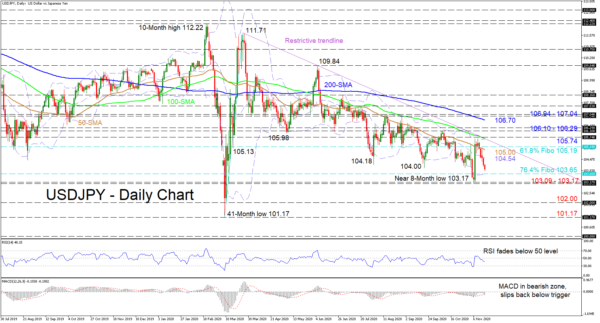USDJPY is descending, having already logged four downward red candles in previous sessions, after retreating from the upper Bollinger band and 100-day simple moving average (SMA). The pair’s return underneath the 50-day SMA and the mid-Bollinger band are being endorsed by the dominant bearish tone of the SMAs and the restrictive trend line, drawn from the 111.71 top.
The short-term oscillators are mirroring the negative price action, backing the bearish structure below the downward sloping trend line. The MACD, in the negative region, is slipping back below its red signal line, while the RSI is waning in the bearish territory.
If the plunge continues to evolve, initial support may develop from the 103.65 level that happens to be the 76.4% Fibonacci retracement of the up leg from 101.17 to 111.71, and where the lower Bollinger band is currently located. Falling below this point, the support section of 103.09-103.17, which involves the trough of March 12 and the fresh near eight-month low, could make efforts to terminate the decline. Should this critical border fail to do so, the pair may plummet towards the 102.00 handle before sellers aim for the 41-month low of 101.17.
Reversing higher, buyers could face early constraints from the mid-Bollinger band at 104.54 and the 50-day SMA around 105.00. Subsequently, the nearby 61.8% Fibo of 105.19 and the restrictive trend line could provide significant resistance, keeping the picture negative. However, should the price push above the line, it may encounter the upper Bollinger band and the 100-day SMA presently around the high of 105.74. Additional gains could then challenge the 106.10-106.29 limiting band, keeping in their view the 200-day SMA at 106.70.
Summarizing, a break below the 103.09 mark may accelerate the negative bias, while a shift above 106.94-107.04 may boost optimism.













